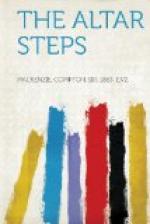Wych, a large village on a spur of the Cotswold hills, was actually in Oxfordshire, although by so bare a margin that all the windows looked down into Gloucestershire, except those in the Rectory; they looked out across a flat country of elms and willow-bordered streams to a flashing spire in Northamptonshire reputed to be fifty miles away. It was a high windy place, seeming higher and windier on account of the numbers of pigeons that were always circling round the church tower. There was hardly a house in Wych that did not have its pigeon-cote, from the great round columbary in the Rectory garden to the few holes in a gable-end of some steep-roofed cottage. Wych was architecturally as perfect as most Cotswold villages, and if it lacked the variety of Wychford in the vale below, that was because the exposed position had kept its successive builders too intent on solidity to indulge their fancy. The result was an austere uniformity of design that accorded fittingly with a landscape whose beauty was all of line and whose colour like the lichen on an old wall did not flauntingly reveal its gradations of tint to the transient observer. The bleak upland airs had taught the builders to be sparing with their windows; the result of such solicitude for the comfort of the inmates was a succession of blank spaces of freestone that delighted the eye with an effect of strength and leisure, of cleanliness and tranquillity.
The Rectory, dating from the reign of Charles II, did not arrogate to itself the right to retire behind trees from the long line of the single village street; but being taller than the other houses it brought the street to a dignified conclusion, and it was not unworthy of the noble church which stood apart from the village, a landmark for miles, upon the brow of the rolling wold. There was little traffic on the road that climbed up from Wychford in the valley of the swift Greenrush five miles away, and there was less traffic on the road beyond, which for eight miles sent branch after branch to remote farms and hamlets until itself became no more than a sheep track and faded out upon a hilly pasturage. Yet even this unfrequented road only bisected the village at the end of its wide street, where in the morning when the children were at school and the labourers at work in the fields the silence was cloistral, where one could stand listening to the larks high overhead, and where the lightest footstep aroused curiosity, so that one turned the head to peep and peer for the cause of so strange a sound.
Mr. Ogilvie’s parish had a large superficial area; but his parishioners were not many outside the village, and in that country of wide pastures the whole of his cure did not include half-a-dozen farms. There was no doctor and no squire, unless Will Starling of Rushbrooke Grange could be counted as the squire.
Halfway to Wychford and close to the boundary of the two parishes an infirm signpost managed with the aid of a stunted hawthorn to keep itself partially upright and direct the wayfarer to Wych Maries. Without the signpost nobody would have suspected that the grassgrown track thus indicated led anywhere except over the top of the wold.




